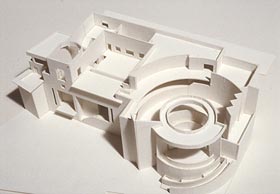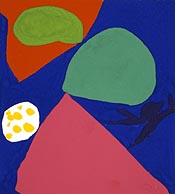|
An artists' town |
Tate in St Ives |
The architecture |
The building |
The collection |
The opening
The architecture

In 1989 a competition to select an architect for the gallery was organised and five architectural firms were invited to submit proposals.
| Apart from the obvious attraction of the exhibits the Gallery should attract visitors in its own right ... the building should be stimulating, imaginative
and excellent.
It should be equally attractive to the art enthusiast and to the family on holiday. |

Quotation from the architect's competition brief, 1989 |
In early January 1990 the designs of husband and wife team David Shalev and Eldred Evans were chosen by the panel, which included Tate's new Director
Nicholas Serota.
The architects proposed a bold design featuring a circular entranceway which echoed the shape of the gas holder previously sited there.
This entrance space, rather like an amphitheatre, allowed for a breathtaking curved gallery above, with views overlooking the Atlantic. |

Architect's model of Tate St Ives
© Evans & Shalev Architects |
Arranged over four floors, the designs revealed a building which echoed the architecture of the town:
 Patrick Heron stained glass window design for Tate St Ives
Patrick Heron stained glass window design for Tate St Ives
© Estate of Patrick Heron 2003. All Rights
Reserved, DACS |
| Each of the spaces in the building is a different shape and a different volume and communicates a different sense of perception of the space as you
move through it which, as the architects say, is an extension of visiting the town itself.
St Ives is full of quirky spaces sudden changes of volume and then glimpses of the sea beyond. |
Michael Tooby, Director of St Ives
in his lecture 'St Ives: The Tate and the Future',
Tate Gallery Millbank, 31 January 1993
Listen
to the Mike Tooby lecture  |
The coastal landscape of the surrounding area was also a great influence on the architects.
They stated their wish to create a 'dialogue' between the building and its environs, creating exhibition spaces that reflected the very landscape that had provided the
inspiration for much of the artwork displayed on its walls.
Local artists helped shape the final appearance of the building.
Most notably, Patrick Heron designed a huge stained glass window for the entrance hall. |
|
